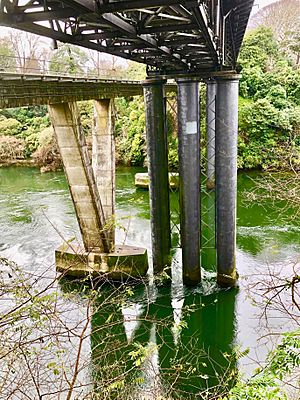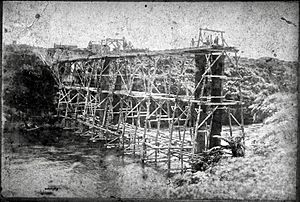Claudelands Bridge facts for kids
Quick facts for kids Claudelands Bridge |
|
|---|---|

Claudelands rail and road bridges.
|
|
| Coordinates | 37°47′04″S 175°17′00″E / 37.784418°S 175.283432°E |
| Carries | 2 lanes of Claudelands Rd |
| Crosses | Waikato River |
| Locale | Hamilton, New Zealand |
| Maintained by | Hamilton City Council |
| Preceded by | Victoria Bridge, Hamilton |
| Followed by | Whitiora Bridge |
| Characteristics | |
| Design | Warren truss |
| Material | Steel |
| Total length | 436 feet (133 m) |
| Height | 103 feet (31 m) river bed to road |
| Longest span | 132 feet (40 m) |
| Number of spans | 5 |
| Piers in water | 2 x 3 (until 1906 2 x 2) |
| Clearance below | 82 feet (25 m) |
| History | |
| Designer | Office of John Blackett |
| Construction begin | 1880 |
| Opened | 1883 rail bridge, converted to road 1968 |
| Statistics | |
| Daily traffic | 2010 11900 2011 11400 2012 11000 2013 10800 2014 11900 2015 11600 2018 11,200 |
| Designated: | 5 September 1985 |
| Reference #: | 4201 |
The Claudelands Bridge is a road bridge in Hamilton, New Zealand. It crosses the Waikato River, connecting the areas of Claudelands and Hamilton Central. This bridge is special because it used to be a railway bridge!
It was first built as a railway bridge in 1883. Then, in 1968, it was changed into a road bridge for cars and other vehicles. In 1985, it was recognised as a special historic place with a Category 2 listing. This means it's an important part of New Zealand's history.
Today, about 11,000 vehicles use the bridge every day. It's also very popular for cyclists. To make it safer for the many cyclists, special road markings called "sharrows" were added in 2019. Buses also use this bridge to travel across the city.
Contents
The New Railway Bridge
A brand new railway bridge was opened on 19 September 1964. It's located just a few metres downstream from the old bridge. This new bridge is made of strong, pre-stressed concrete and has seven sections.
It was the first bridge in New Zealand to use a special "Freyssinet cable" for strengthening. The new railway bridge is also lower than the road bridge, sitting about 18 metres (59 feet) above the river.
History of the Old Bridge
The original Claudelands Bridge was designed in 1880. Building started in 1881, but it was a slow process. The first builder had problems, so a new builder took over in 1882.
Work stopped again in November 1882 because the foundations weren't strong enough. They had to make the foundations much deeper, from 3 feet to 24 feet (about 7.3 metres). The bridge was finally finished on 21 September 1883. It was first used for construction trains. The railway line from Hamilton to Morrinsville officially opened in October 1884.
Strengthening the Bridge
When it was first built, the bridge was tested with a heavy load of 117 tons. As trains became heavier, the bridge needed to be made stronger. In 1906, extra support columns were added to the main part of the bridge. A new bridge deck (the top part where trains ran) was also added in 1907.
Even more strengthening was done in 1934. This was to help the bridge handle very heavy locomotives, like the 135-ton K-Class trains.
Adding a Footbridge
People wanted a way to walk across the river even before the railway bridge opened. In 1908, a special walkway for people was added to the side of the bridge. However, people complained that it didn't have lights, and cycling was not allowed on it. The footbridge was updated again in 1936.
Moving the Railway
Over time, people in Hamilton wanted the railway tracks moved out of the city centre. There were plans to lower the railway line or even put it in a tunnel. In 1959, work began on a big project to move the railway into a tunnel and build a new bridge at the tunnel's level. This led to the new railway bridge being built and the old one being changed into a road bridge.
Utilities on the Bridge
The Claudelands Bridge also carries important services across the river. From 1970 to 1974, electricity cables were laid across the bridge. More wiring was added in 1988.
Images for kids



